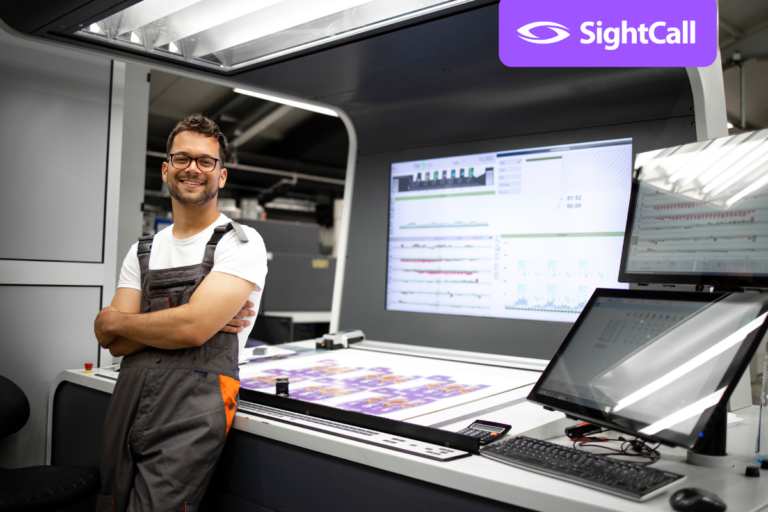Downtime.
The dreaded D-word.
Whether planned or unplanned, operational downtime of key equipment is costly if not resolved effectively and efficiently.
Sometimes maintenance tasks can take longer than expected to diagnose and resolve, delaying operations and reducing productivity. Other times, hours and resources are wasted sending a field service technician out to a site to resolve a simple problem (or worse, to find that there was no problem at all).
And issues that are not resolved quickly can lead to dissatisfied customers.
Situations that lead to downtime will always require time to resolve. But with the right tools, repair and maintenance tasks can be streamlined to reduce days to hours and sometimes even minutes… saving you time, money, and customer relationships.
One of these tools is AI-enhanced visual assistance, the core of the SightCall VISION platform for enterprise service organizations.
What is AI-Enhanced Visual Assistance?
AI-enhanced visual assistance tools add a visual component to typical customer service methods like call centers, chatbots, and email support.
These visual tools allow field service technicians and customers to communicate information to remote experts visually, reducing the potential for misunderstandings from verbal descriptions of situations or solutions.
They also can reduce the need for communication with an agent altogether, with multimodal generative AI capable of interpreting visual information from a field technician or customer (such as an image or video of broken equipment), combined with text prompts, to generate a solution to the problem.
By integrating AI-enhanced visual assistance, customer service providers can elevate the customer and field service experiences by enabling faster problem solving.
Five Ways AI-Enhanced Visual Assistance Speeds Up Repairs

Real-Time Diagnostics
Sometimes diagnosing a problem can be the most time-consuming part of the troubleshooting process. A customer may not have the expertise to quickly diagnose problems when issues with equipment come up, so they call your customer support team and attempt to describe the issue.
When a solution cannot be achieved over the phone, they schedule a date for a technician to come out to the field, only for the technician to finally arrive and fix the problem in two minutes.
The wasted time, travel, and costs associated with this process can be saved by giving your customers self-service, easy to follow visual instructions for independent repair.
For example, a customer can receive a product specific link for a kitchen appliance when they upload a photo of the item or image of a barcode. If the customer needs more help, they can switch to visual support from an agent who already has the customer’s appliance information in hand.
WATCH: Visual AI & Self-Service with SightCall VISION

Enhanced Context Between Experts and Field Technicians
Field technicians know their stuff and are highly capable of addressing most problems when working onsite. But sometimes, even they need a little help from an expert.
According to a 2023 Service Council report, when field service techs get stuck, 81% of them choose to “phone a friend.”
With AI-enhanced visual assistance, those calls go beyond the standard phone call. Using two-way visual conversations, a field technician can provide a live video and audio feed of the issue they are working on.
The expert can follow up with augmented reality guidance that the technician can see and follow along with in real time.

Automated AI Documentation and Reporting
Documentation.
The other dreaded D-word.
Oftentimes the most time-consuming part of a maintenance call are the administrative tasks that follow the actual work. Recording all the observations, diagnoses, solutions, maintenance actions, and final decisions in a report once a maintenance visit is complete can be tedious after hours (or days) spent working on site.
According to the data from the Service Council, 52% of field techs say they spend too much time on paperwork.
Multimodal generative AI can help reduce manual effort by automatically building reports from images, video, audio, and text compiled over the course of a given site visit.
These reports can go as far as including annotated images, audio transcriptions, and detailed procedure notes, all automated using AI and eliminating the need for a field technician to manually create the documentation.

Predictive Maintenance and Preemptive Repairs
AI-enhanced visual assistance can help minimize downtime even before it happens, by providing automated visual guides for maintenance, repair, and installation.
AI tools can analyze equipment to identify replacement parts and provide automated recommendations based on voice, image, and text diagnoses of situations. Field engineers and customers can use these tools to handle maintenance tasks without the need of remote expert engineers.
And remote support with human-guided visual assistance is at the ready and can be called upon if needed for complex situations.

Training and Skill Enhancement
Knowledge is power. Empowering customers and field technicians through AI-facilitated visual training can help them tackle issues more confidently, competently, and efficiently, cutting down on time spent resolving problems and reducing the need to call for expert support.
From sharing best practices to facilitating knowledge transfer within your organization, AI-enhanced visual assistance can help your service teams provide more robust support to your customers.
READ OUR WHITE PAPER: How to Reduce the Field Service Talent Shortage with Visual Assistance and AI
Future Outlook
AI’s evolution will be instrumental in promoting sustainable practices within the service industry. By optimizing maintenance schedules and extending equipment lifespan, AI will play a pivotal role in reducing environmental impact.
As these technologies continue to evolve, they hold the promise of not just enhancing service quality but also fostering a more sustainable and knowledge-driven future for customer service professionals across the globe.



